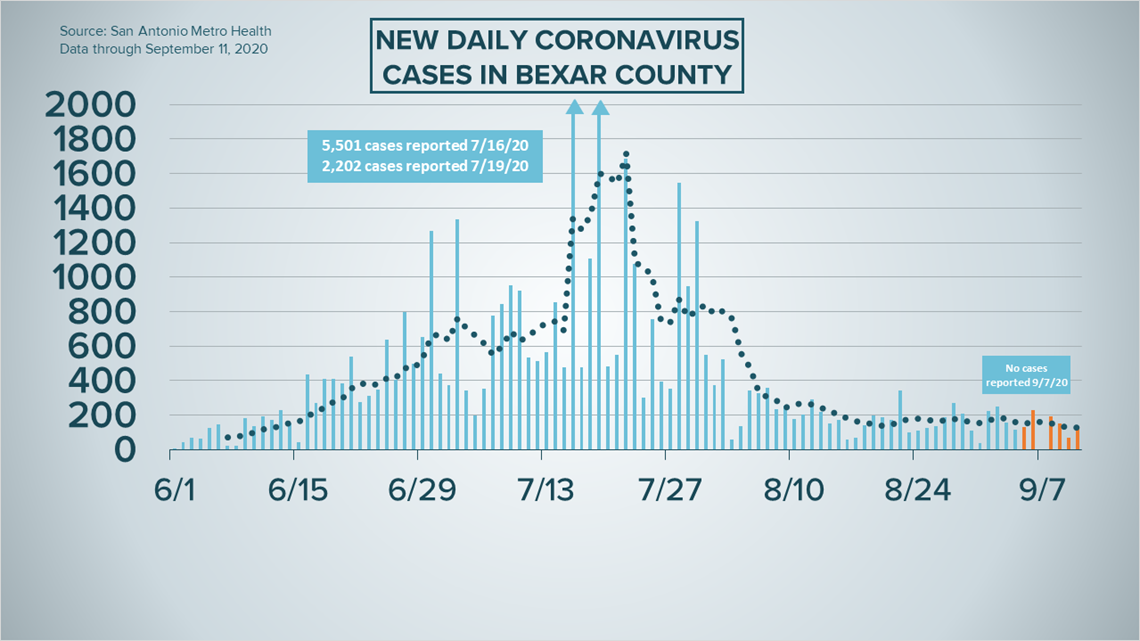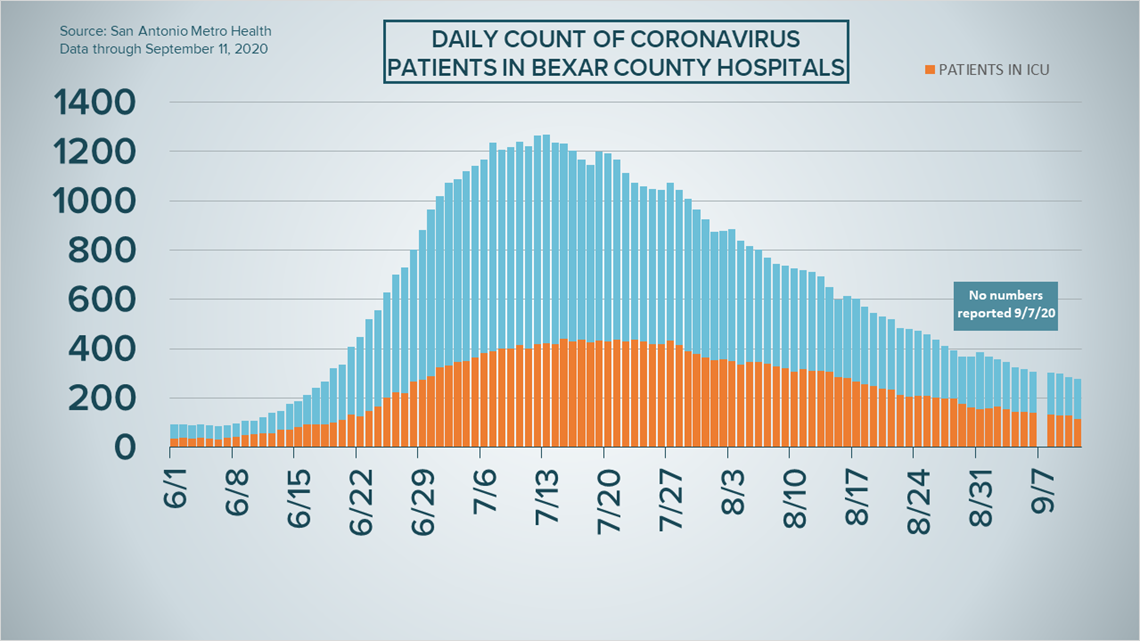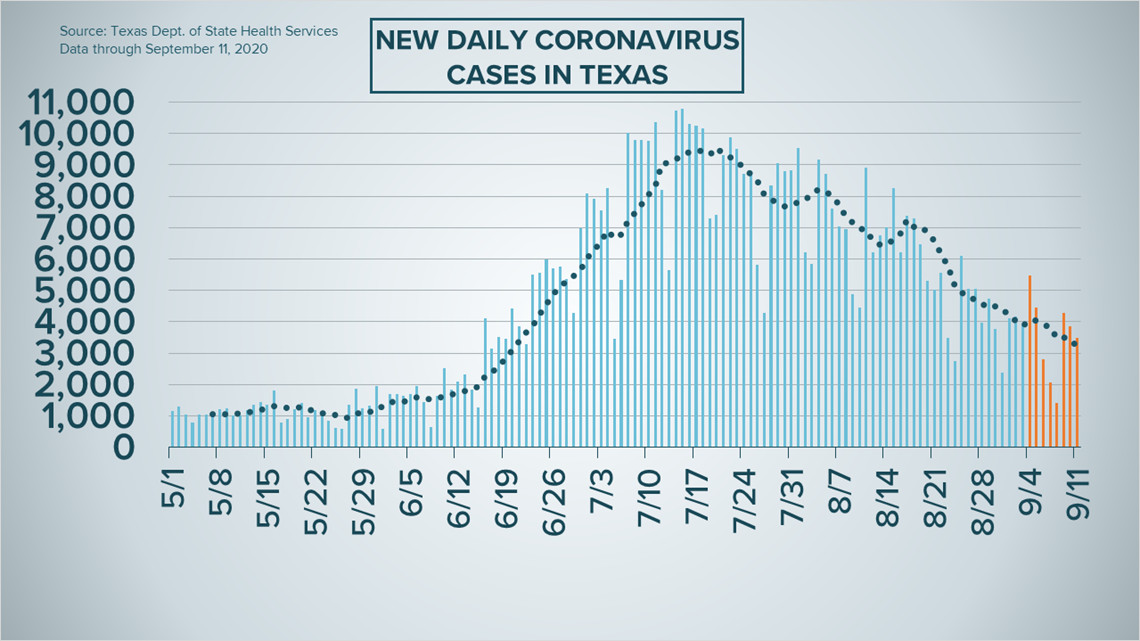SAN ANTONIO — We're tracking the latest numbers from the coronavirus pandemic in San Antonio and across Texas. Here are the latest numbers reported by Bexar and surrounding counties:
- Bexar County: 118 new cases were reported Friday, bringing the total number for the county to 48,074. The county death toll, meanwhile, rose to 991 after one new fatality was reported.
- Comal County: The county reported 12 additional cases and no additional deaths Friday. There have been a total of 3,140 cases of COVID-19 in the county – including 2,495 confirmed cases – while 114 county residents have died. County officials say there are 320 active coronavirus cases, and 2,706 residents are considered recovered.
- Hays County: Officials in Hays County on Friday reported 30 new cases in the county and no additional virus-related deaths. As of Friday, there are a total of 5,598 lab-confirmed cases in the county (1,914 of which are active) while the death toll stands at 51. 3,602 are considered recovered.
How Bexar County is trending
We've tracked how many coronavirus cases have been confirmed in Bexar County from the time officials began reporting cases in March 2020. The graphic below shows the number of cases since June and charts those daily case numbers along a 7-day moving average to provide a more accurate picture of the overall coronavirus case curve in our area and the direction we're trending amid the pandemic.
On Friday, Mayor Ron Nirenberg reported an additional 118 coronavirus cases in Bexar County, bringing the total to 48,074. Nirenberg also reported one additional virus-related death in the community. In all, 991 Bexar County residents have died from coronavirus complications.


Hospitalizations also continued to drop in Bexar County. On Friday, a total of 278 residents were being treated for COVID-19 symptoms, which is six fewer than Wednesday. The number of patients utilizing ventilators (59) and in intensive care (113) significantly declined Friday.


Coronavirus in Texas
The Texas Department of State Health Services on Friday reported an additional 3,488 cases of the novel coronavirus across the state. As of Friday, at least 653,356 Texans have been infected with COVID-19.


Meanwhile, the state also reported an additional 144 coronavirus-related deaths on Friday, raising the death toll to 13,997.
An estimated 568,067 Texans have recovered from the coronavirus, while the state estimates nearly 71,292 cases remain active. The number of patients currently in Texas hospitals dropped by 110 to 3,465 on Friday.
As the school year begins to get underway for local districts, we are also keeping track of the most important updates for each, including links to dashboards created to track coronavirus cases.
Latest Coronavirus Headlines
- Hays County reports 1,914 active COVID-19 cases, 51 deaths
- 9/11 anniversary marked by changes due to coronavirus
- 'Zoo Boo!' to offer drive-thru trick-or-treating this year
- Daily US coronavirus deaths decline, but trend may reverse in fall
- Home Depot reveals Black Friday plan with 2 months of deals
- Senate GOP scaled-down virus relief bill fails, likely ends hope of aid before election
Coronavirus symptoms
The symptoms of coronavirus can be similar to the flu or a bad cold. Symptoms include fever or chills, cough, shortness of breath or difficulty breathing, fatigue, muscle or body aches, headache, new loss of taste or smell sore throat, congestion or runny nose, nausea or vomiting and diarrhea, according to the Centers for Disease Control.
Most healthy people will have mild symptoms. A study of more than 72,000 patients by the Centers for Disease Control in China showed 80 percent of the cases there were mild.
But infections can cause pneumonia, severe acute respiratory syndrome, kidney failure, and even death, according to the World Health Organization. Older people with underlying health conditions are most at risk.
But infections can cause pneumonia, severe acute respiratory syndrome, kidney failure, and even death, according to the World Health Organization. Older people with underlying health conditions are most at risk.
Experts determined there was consistent evidence these conditions increase a person's risk, regardless of age:
- Chronic kidney disease
- COPD (chronic obstructive pulmonary disease)
- Obesity (BMI of 30 or higher)
- Immunocompromised state (weakened immune system) from solid organ transplant
- Serious heart conditions, such as heart failure, coronary artery disease, or cardiomyopathies
- Sickle cell disease
- Type 2 diabetes
The CDC believes symptoms may appear anywhere from two to 14 days after being exposed.
Human coronaviruses are usually spread...
- Between people who are in close contact with one another (within about 6 feet).
- Through respiratory droplets produced when an infected person coughs, sneezes or talks. These droplets can land in the mouths or noses of people who are nearby or possibly be inhaled into the lungs.
- Some recent studies have suggested that COVID-19 may be spread by people who are not showing symptoms.
Help stop the spread of coronavirus
- Stay home when you are sick.
- Eat and sleep separately from your family members
- Use different utensils and dishes
- Cover your cough or sneeze with your arm, not your hand.
- If you use a tissue, throw it in the trash.

